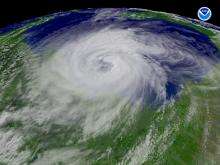NOAA National Weather Service to Use New Hurricane Wind Scale

(PhysOrg.com) -- NOAA's National Weather Service will use a new hurricane scale this season called the Saffir-Simpson Hurricane Wind Scale. The scale keeps the same wind speed ranges as the original Saffir-Simpson Scale for each of the five hurricane categories, but no longer ties specific storm surge and flooding effects to each category.
Herbert Saffir, a consulting engineer, and Robert Simpson, who was director of the National Hurricane Center from 1967 through 1973, developed the original scale which was a useful tool to convey the threats of tropical cyclones. Changes were made to the Saffir-Simpson Scale because storm surge values and associated flooding are dependent on a combination of the storm’s intensity, size, motion and barometric pressure, as well as the depth of the near-shore waters and local topographical features. As a result, storm surge values can be significantly outside the ranges suggested in the original scale.
For example, Hurricane Ike in 2008 was a very large storm that made landfall on the upper Texas coast as a Category 2 hurricane with a peak storm surge of 15 to 20 feet. In contrast, Hurricane Charley struck Southwest Florida in 2004 as a Category 4 hurricane, but produced a peak storm surge of just 6 to 7 feet.
Storm surge forecasts will continue to be included in hurricane advisories and statements issued by the National Hurricane Center and local National Weather Service forecast offices. Beginning with the 2009 hurricane season this information has been expressed in terms of height above ground level giving residents a better understanding of the potential for flooding at their location.
The decision to implement the Saffir-Simpson Hurricane Wind Scale was based, in part, on an assessment of the responses received during a 2009 public comment period. The descriptions of wind impacts in the new scale were updated with assistance from highly respected wind scientists from academia and industry.
"I applaud the NOAA decision to decouple storm surge predictions from the Saffir-Simpson scale,” said Al Goodman, Floodplain Management Bureau director, Mississippi Emergency Management Agency. Goodman noted that while Hurricane Katrina hit the Gulf Coast with top winds of Category 3 strength, its expected and actual storm surge was associated with a higher Category of storm when ranked on the original Saffir-Simpson Scale.
More information: www.nhc.noaa.gov/aboutsshs.shtml
Provided by NOAA

















